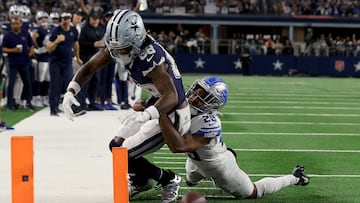NFL
What is a touchback in the NFL? When does it happen?
With the league having altered the rules, it’s important you all understand exactly what a “touchback” is in the NFL and how it works.

We’ve seen it time and time again during plays where one team is forced to punt. The kicking team will attempt to get the ball as deep as possible into to opponent’s territory, in the hope of pinning them back, thereby making their uphill climb that much steeper, however, we’ve also seen this backfire on countless occasions. Instead, teams can sometimes find themselves in the end zone which in turn leads to the touchback.
Follow Chiefs - Ravens live online: AFC Championship game today score & stats | NFL Playoffs.
Needless to say, this has led to loud and sustained calls to do away with the kickoff altogether. Yet, how did we get here? Given the NFL’s penchant for rule changes - incessant meddling some might call it - surely the touchback would have gone the way of the dodo long ago if it was always like this? Except not.
How does the touchback occur?
Here’s how this works. If a kicked ball, either as a result of a punt, kickoff or missed field goal, touches the ground in the opposing team’s end zone, rolls out of the back-end zone or touches the goal post, the play is ruled a touchback and the ball is subsequently spotted on the 25-yard-line. Touchbacks can also be called if the receiver waves for a fair catch before catching the ball or takes a knee once the ball is caught, however, these two are now anachronisms after rule changes in 2004 and 2011. Indeed, as a result of these alterations, if the ball is left to bounce, the call is the same.
Incidentally, a touchback can also be called if the ball is fumbled through the end zone. Understandably, this is not the norm and when it does occur, it has often led to confusion for fans, but it is common enough that it had to be addressed. A perfect example would be 2020′s AFC Divisional Round playoff game against the Kansas City Chiefs. Following a fumbled or near-touchdown pass through the end zone, the Browns found themselves with the short end of the stick and a touchback, which in turn resulted in their loss to the Chiefs.
What changes has the NFL made?
On Tuesday, NFL owners voted to approve a resolution which will allow players to fair catch on kickoffs, with the resulting possession starting at the team’s own 25-yard line. Further to that, the new rule also states that that the fair catch off of a free kick (safety or kickoff) must occur behind the team’s 25-yard line in order for the ball to be placed at the 25.
Interestingly, the rule change has been implemented for just one year, with the league using “player safety” as the central reason for the new proposal. In case you’re wondering, the new rule was initially put on the table by the NFL’s competition committee back in March, with the intention that it be discussed at the Annual League Meeting, as part of the league’s effort to reduce injuries suffered by special teams plays. Though discussions were delayed by about two months, the vote has finally been made and here we are.
Was it always this way?
Prior to the 2004 and 2011 rule changes, a kickoff was a live ball once it passed ten yards, meaning that the kicking team could recover a ball in the end zone and that would be a touchdown. On a personal side note, my own high school football years saw East Ascension High School lose by seven to St Amant High School as a result of just such a play during my junior year. A punted ball was something slightly different but the ball was still live until either touched by the kicking team or recovered. If recovered, and not kneeled but rather tackled inside the end zone, the result was a safety, seeing the kicking team awarded two points. A missed field goal is still a live ball, for now.
Results of these changes
Since the 2011 rule change which saw the kickoff moved up to the 35-yard line from the 30, the resulting touchbacks increased dramatically. Where 16% of kickoffs resulted in touchbacks previously, that number jumped to 44% the following season. Barring a radical strategy shift, that ratio is not likely to come down any time soon.
Why all the fiddling with the rules?
The NFL has for years known that the most dangerous play in the game is the kickoff. It accounts for the vast majority of injuries and hospital admissions associated with the game. It is one of the last vestiges, perhaps even the last, of the game’s origins in rugby, where the perhaps chaotic, but free-flowing play is more prized over set pieces. This places the kickoff firmly at odds with the modern NFL. And they have done much over the years to mitigate the injury.
Kicking teams may no longer get a running start, the field is shorter to encourage more touchbacks, and the rules surrounding the live ball and just what a touchback is are just the latest in a long line of tinkering by the rules committee. At this point, we can only wonder if the next time the topic of ‘touchbacks’ comes up, it’s because the league has finally decided to do away with them altogether.






